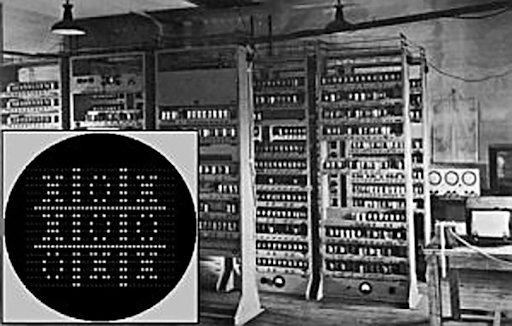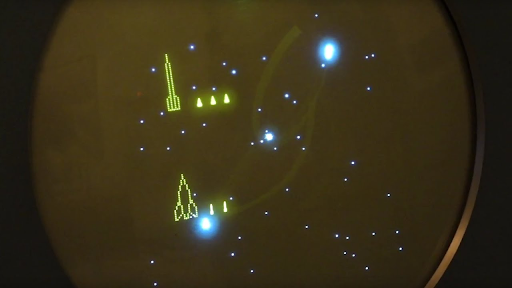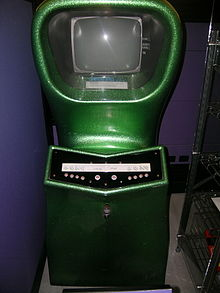How it started - the birth of video games
About the birth of video games - how it started
Today games on electronic devices are commonplace. For some games - entertainment, for others - work, for the third - art. I would like to partially touch on each of these facets, which I will try to do in this article.
1. Start

The first leap towards modern computer games was made in 1947, when American physicists Thomas Goldsmith, Jr. and Astle Ray Mann patented “an entertainment device based on a cathode ray tube.” The device imitated the flight control of a rocket, and the gameplay was based on controlling the oscilloscope beam and defocusing it to “defeat” the targets shown on the overlay on the screen. Since all the electronics used were analog, not digital, and due to the lack of image rendering as such, the resulting device is considered an electronic game, not a video game. However, the patent was published, a start was made, the idea was born.
2. Large glands and small screens

The next step in the development was the game “OXO” for the computer EDSAC. Alexander Douglas wrote it as an aid for the candidate on the topic of human-computer interaction. Of course, this game did not spread because of the uniqueness and specificity of the equipment on which it worked. Presumably, OXO is the first game with a raster display. However, as already mentioned, this was only an illustration of a thesis, so the resulting product can hardly be considered a full-fledged game. But the attempt is counted and the feat of Douglas will not be forgotten.
3. Electronic Tennis

Another step was the game “Tennis for Two”. In 1958, Dr. William Higginbotham worked on a simulation of jumping balls and rocket trajectories that could predict the path of motion of objects. And suddenly he got the idea to move the simulation to tennis. The display is again carried out on an oscilloscope. In this project, a computer is already used, so it can be considered the first analog computer game. A patent for technology Higinbotam not designed, because the design of the device was similar to the development of the doctor in his state laboratory, so all patents would belong to the government. And the device itself was made more as a means of enticing people at the open door in the Brookhaven laboratory, rather than as an invention.
It was not difficult to notice that the first games were created as side effects of research projects. But with the development of VMs (computers), games more and more often began to flash games not as a creative approach to the demonstration of technological advances, but as an entertainment element.
4. Forward to the stars

In April 1962, saw the light of the game "Spacewar!". This game can be considered the first full-fledged digital computer game. It was created by Steve Russell with the participation of Martin Gretz and Wayne Whitanem, united in an informal creative group called "Hingham Institute". This group in 1961 decided to create a game with the aim of its implementation on the DEC PDP-1 at the Massachusetts Institute of Technology. Thus, we have not only the first digital game, but also the first development team. The game itself was designed for two players who control the spacecraft and try to knock each other down. Some time later, a sequel appeared in the game called “Expensive Planetarium” (referring to the cost of the PDP-1 computer). In the original, the starry sky in the background was randomly generated, in the new version, real star charts were used, and the background changed just as the appearance of the starry sky changed day and night. Also added various game settings that could be turned on and off: stars with their gravity, motion by inertia, background, effects of other objects on the trajectory of the ship and the player’s missiles.
“Spacewar!” Was a great success in the 60s, it was ported to other systems. By the way, Gabe Newell was born on November 3, 1962, but this is a completely different story.
Unfortunately, the focus of the then computer igrodelov further shifted towards text games, so now it is time to switch to another branch of the game development. Entrepreneurial people quickly figured out what was happening and began to work towards the development of slot machines.
Well, and then suddenly came 1971, and Bill Pitts and his company Computer Recreations set up the first commercial slot machine with the game “Galaxy Game” (yes, this is the very “Spacewar!”, Only modified) at Stanford University. Among students, the machine was a huge success, but due to the huge cost and low payback, it remained at Stanford.
5. The last spurt

Following the “Galaxy game”, after 2 months, the gaming machine “Computer Space” from Nutting Associates, led by Nolan Bushnell and Ted Dabney, is released. Playing the machine, again, is the heir to “Spacewar!”, Which Bushnell saw as a university student. At the expense of sponsorship from Nutting Associates, where Bushnell came out with one session at the dentist, the device received a ticket to a brighter future. The devices and the game turned out to be quite specific:
- the available computers of the time did not “pull” the game as they wanted, so the hardware had to be customized to the needs of the game;
- Two players gave a strong load on the device, so the version was cut to a single game against several bots.
Despite all the greatness of the apparatus, the control of a space submarine turned out to be too complicated for the perception of the working class, which the manufacturer was guided by. In total, about 1,500 machines with the game were produced and sold, and Nolan Bushnell himself left Nutting Associates in May 1972 and, together with his friend Ted Dabney, developed their joint company Syzygy Engineering, which they renamed Atari.
6. Conclusion
Perhaps at this point it is worth staying. Of course, much was not said, many interesting facts remained behind the scenes. Starting in 1972, video games began to develop rapidly, companies emerged and fell apart, merged and separated. Created middle aids, who had no success, and masterpieces that will be remembered for more than a decade. But these are other stories. In the meantime, play and rejoice.
